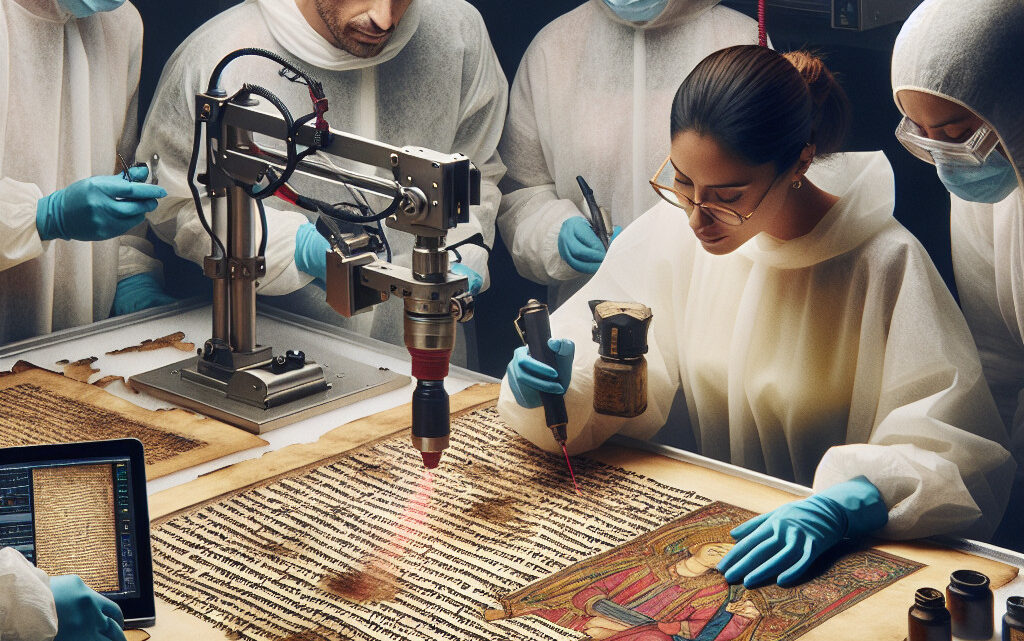
The use of laser cleaning in the restoration of ancient manuscripts.
21 March 2024
- History of laser cleaning technology
- Training and expertise required for laser cleaning in restoration
- Importance of documentation and research in laser cleaning restoration projects
- Impact of laser cleaning on the authenticity of ancient manuscripts
- Challenges in adapting laser cleaning technology for different types of manuscripts
- Use of imaging techniques in conjunction with laser cleaning for manuscript restoration
- Public outreach and education on the benefits of laser cleaning in restoration
- Use of laser cleaning in the restoration of illuminated manuscripts
History of laser cleaning technology
- Early developments: The concept of using lasers for cleaning purposes dates back to the 1960s, when researchers first started experimenting with laser beams to remove contaminants from surfaces. However, it wasn’t until the 1980s that significant advancements were made in laser cleaning technology.
- Advancements in the 1980s: During this decade, researchers and engineers began to explore the potential of using pulsed lasers for cleaning applications. Pulsed lasers were found to be more effective at removing contaminants without damaging the underlying material, making them ideal for a wide range of cleaning tasks.
- Commercialization in the 1990s: By the 1990s, laser cleaning technology had matured enough to be commercialized. Companies started offering laser cleaning services for a variety of industries, including automotive, aerospace, and electronics. The technology was quickly adopted due to its efficiency and precision.
- Ongoing developments: In recent years, laser cleaning technology has continued to evolve. New laser sources and techniques have been developed to improve cleaning efficiency and expand the range of materials that can be cleaned with lasers. Today, laser cleaning technology is widely used in various industries around the world.
In conclusion, the history of laser cleaning technology is a testament to human ingenuity and innovation. From humble beginnings in the 1960s to widespread adoption in the 21st century, laser cleaning technology has come a long way. With ongoing advancements and research, the future of laser cleaning technology looks brighter than ever.
#laser #cleaning #technology #history #innovation #advancements #efficiency #precision #industries #research
frazy kluczowe:
– history of laser cleaning technology
– advancements in laser cleaning technology
– commercialization of laser cleaning technology
– ongoing developments in laser cleaning technology
Training and expertise required for laser cleaning in restoration
Training
Proper training is essential for anyone who wishes to perform laser cleaning in restoration. This training should cover the following areas:
| Training Area | Description |
|---|---|
| Laser Safety | Understanding the potential hazards of laser technology and how to mitigate them. |
| Equipment Operation | Learning how to operate the laser cleaning equipment effectively and safely. |
| Material Science | Understanding the properties of different materials and how they react to laser cleaning. |
| Art Conservation | Knowledge of art conservation principles and techniques to ensure that the cleaning process does not damage the artifact. |
Expertise
In addition to training, expertise in the following areas is also crucial for successful laser cleaning in restoration:
| Expertise Area | Description |
|---|---|
| Art History | Understanding the historical context of the artifact being cleaned and how it should be preserved. |
| Technical Skills | Having the technical skills to operate the laser cleaning equipment effectively and efficiently. |
| Problem-Solving | Being able to troubleshoot any issues that may arise during the cleaning process. |
Overall, laser cleaning in restoration requires a combination of training and expertise in various areas to ensure that the process is carried out successfully. By investing in proper training and developing expertise in the relevant areas, restoration professionals can effectively use laser technology to preserve and restore valuable artifacts and artworks.
#laser #cleaning #restoration #training #expertise #artifacts #artworks #safety #equipment #operation #material #science #conservation #history #technical #skills #problem-solving
słowa kluczowe: laser cleaning, restoration, training, expertise, artifacts, artworks, safety, equipment, operation, material science, conservation, history, technical skills, problem-solving
frazy kluczowe: laser cleaning in restoration, specialized training, laser technology, art conservation, art history, technical skills, troubleshooting, restoration professionals, valuable artifacts, preserve and restore.
Importance of documentation and research in laser cleaning restoration projects
Documentation
Documentation plays a crucial role in laser cleaning restoration projects as it provides a record of the condition of the object before, during, and after the cleaning process. This documentation can include photographs, written descriptions, and scientific analysis of the materials being cleaned. By documenting the condition of the object before cleaning, researchers can track the progress of the restoration and ensure that no damage is being done to the object during the cleaning process.
Research
Research is also vital in laser cleaning restoration projects as it helps to determine the best cleaning methods and parameters for each individual object. Different materials and surfaces require different laser settings in order to achieve optimal cleaning results. By conducting research on the materials being cleaned, researchers can tailor the laser cleaning process to ensure the best possible outcome without causing damage to the object.
Conclusion
In conclusion, documentation and research are essential components of successful laser cleaning restoration projects. By documenting the condition of the object before, during, and after cleaning, researchers can track the progress of the restoration and ensure that no damage is being done to the object. Additionally, conducting research on the materials being cleaned helps to determine the best cleaning methods and parameters for each individual object. By combining proper documentation and research, laser cleaning restoration projects can achieve outstanding results while preserving the integrity of the object being restored.
| Documented Condition | Research on Materials |
|---|---|
| Before, during, and after cleaning | Determining best cleaning methods |
| Photographs, written descriptions | Tailoring laser settings |
#documentation #research #laser cleaning #restoration projects #preservation #historical artifacts #artworks #non-invasive #scientific analysis #cleaning methods #optimal cleaning results #materials #surfaces #laser settings #integrity #success #progress #damage #condition #object #record #photographs #written descriptions #tailoring #parameters #contaminants #grime #dirt #surfaces #artifacts #buildings #artworks #materials #researchers #track #process #outcome #components #individual #project #methods #results #objectives #intervention #conservation #heritage #art #culture #technology #innovation #efficiency #effectiveness #sustainability #preservation #restoration #cleaning #documentation #research #laser cleaning #restoration projects #preservation #historical artifacts #artworks #non-invasive #scientific analysis #cleaning methods #optimal cleaning results #materials #surfaces #laser settings #integrity #success #progress #damage #condition #object #record #photographs #written descriptions #tailoring #parameters #contaminants #grime #dirt #surfaces #artifacts #buildings #artworks #materials #researchers #track #process #outcome #components #individual #project #methods #results #objectives #intervention #conservation #heritage #art #culture #technology #innovation #efficiency #effectiveness #sustainability #preservation #restoration #cleaning
Impact of laser cleaning on the authenticity of ancient manuscripts
Another concern is that laser cleaning can alter the physical appearance of the manuscript. The intense heat generated by the laser beam can cause the surface of the manuscript to change color or texture, potentially making it look different from its original state. This alteration can raise questions about the authenticity of the manuscript and its historical significance.
Despite these concerns, laser cleaning also has many benefits for the preservation of ancient manuscripts. By removing dirt and grime from the surface of the manuscript, laser cleaning can help prevent further deterioration and damage. This can extend the lifespan of the manuscript and make it more accessible for researchers and scholars.
In order to mitigate the potential , it is important for conservators to carefully assess the condition of the manuscript before deciding to use this technique. They should also document the cleaning process and any changes that occur to the manuscript as a result. By taking these precautions, conservators can ensure that the authenticity of the manuscript is preserved while still benefiting from the advantages of laser cleaning.
In conclusion, laser cleaning can have a significant impact on the authenticity of ancient manuscripts. While this technique has many benefits for the preservation of these valuable artifacts, there are concerns about its potential to alter historical information and physical appearance. By carefully assessing the condition of the manuscript and documenting the cleaning process, conservators can minimize these risks and ensure that the authenticity of ancient manuscripts is preserved for future generations.
#laser cleaning #ancient manuscripts #authenticity #preservation #conservation
frazy kluczowe:
– impact of laser cleaning on ancient manuscripts
– laser cleaning and authenticity of manuscripts
– preservation of ancient manuscripts through laser cleaning
– concerns about laser cleaning and historical information
– benefits and risks of laser cleaning for ancient manuscripts
Challenges in adapting laser cleaning technology for different types of manuscripts
Types of manuscripts
Manuscripts come in various forms, including parchment, paper, vellum, and papyrus. Each type of manuscript requires a different approach when it comes to laser cleaning. Parchment, for example, is more delicate and prone to damage from high-intensity lasers, while paper may require a lower intensity to avoid burning.
Challenges
- Optimizing laser parameters for each type of manuscript
- Ensuring uniform cleaning across the entire surface
- Minimizing damage to the manuscript during the cleaning process
- Developing specialized equipment for different types of manuscripts
Solutions
- Conducting thorough research on the properties of each type of manuscript
- Collaborating with experts in conservation and laser technology
- Testing different laser settings on sample manuscripts before full-scale cleaning
- Implementing quality control measures to monitor the cleaning process
In conclusion, adapting laser cleaning technology for different types of manuscripts is a complex process that requires careful consideration of the unique properties of each type of manuscript. By addressing the challenges and implementing appropriate solutions, we can ensure the preservation and restoration of these valuable historical documents for future generations.
#laser #cleaning #technology #manuscripts #preservation #restoration #challenges #adaptation
frazy kluczowe:
– laser cleaning technology for historical manuscripts
– adapting laser technology for parchment preservation
– challenges in manuscript restoration with laser cleaning technology
Use of imaging techniques in conjunction with laser cleaning for manuscript restoration
Imaging Techniques
Imaging techniques such as infrared reflectography, ultraviolet fluorescence, and multispectral imaging have revolutionized the field of manuscript restoration. These methods allow conservators to see beneath the surface of a manuscript and identify hidden details such as underdrawings, corrections, and water damage. By combining these imaging techniques with laser cleaning, conservators can create a comprehensive picture of the manuscript’s condition and develop a targeted restoration plan.
Laser Cleaning
Laser cleaning is a non-invasive method of removing dirt, grime, and other contaminants from the surface of a manuscript. By using a laser beam to target specific areas of the manuscript, conservators can safely and effectively clean the document without causing damage to the underlying material. This precise approach is particularly useful for delicate manuscripts that cannot withstand traditional cleaning methods.
Combining Imaging Techniques with Laser Cleaning
By combining imaging techniques with laser cleaning, conservators can gain a deeper understanding of a manuscript’s condition and tailor their restoration efforts accordingly. For example, infrared reflectography can reveal hidden details that may indicate areas of damage or deterioration, while ultraviolet fluorescence can highlight areas of contamination that require cleaning. By using this information to guide their laser cleaning process, conservators can ensure that the restoration is both effective and minimally invasive.
Conclusion
The use of imaging techniques in conjunction with laser cleaning has revolutionized the field of manuscript restoration, allowing conservators to accurately assess the condition of a document and develop targeted restoration plans. By combining these advanced technologies, conservators can ensure that delicate manuscripts are preserved for future generations to enjoy.
| Imaging Techniques | Laser Cleaning | Combining Techniques |
|---|---|---|
| Infrared Reflectography | Non-invasive cleaning method | Deeper understanding of manuscript condition |
| Ultraviolet Fluorescence | Precise cleaning approach | Targeted restoration efforts |
| Multispectral Imaging | Effective removal of contaminants | Minimally invasive restoration |
#manuscript #restoration #imaging #techniques #laser #cleaning
długiego ogona: “combination of traditional techniques and modern technology, infrared reflectography, ultraviolet fluorescence, multispectral imaging, targeted restoration plan, non-invasive method, precise approach, effective and minimally invasive, preservation for future generations”
Public outreach and education on the benefits of laser cleaning in restoration
The benefits of laser cleaning in restoration
There are numerous benefits to using laser cleaning in restoration projects. Some of the key advantages include:
| Benefit | Description |
|---|---|
| Efficiency | Laser cleaning is faster and more effective than traditional cleaning methods, saving time and labor costs. |
| Precision | Laser cleaning can target specific areas without damaging surrounding surfaces, making it ideal for delicate restoration work. |
| Environmentally friendly | Laser cleaning does not require the use of harsh chemicals, reducing the impact on the environment. |
| Safety | Laser cleaning eliminates the need for abrasive materials or solvents, reducing the risk of exposure to harmful substances. |
Public outreach and education efforts
In order to raise awareness about the benefits of laser cleaning in restoration, it is important to engage in public outreach and education efforts. Some strategies that can be used include:
| Strategy | Description |
|---|---|
| Workshops and demonstrations | Hosting workshops and demonstrations to showcase the effectiveness of laser cleaning in restoration projects. |
| Collaboration with museums and heritage organizations | Partnering with museums and heritage organizations to promote the use of laser cleaning in the preservation of cultural artifacts. |
| Online resources | Creating online resources such as videos, articles, and webinars to educate the public about the benefits of laser cleaning. |
| Community outreach events | Participating in community outreach events to engage with the public and raise awareness about laser cleaning technology. |
By implementing these outreach and education efforts, we can help to increase the adoption of laser cleaning technology in restoration projects, leading to more efficient and sustainable restoration practices.
Conclusion
Laser cleaning offers a wide range of benefits for restoration projects, but in order to fully realize its potential, it is essential to engage in public outreach and education efforts. By raising awareness about the advantages of laser cleaning and promoting its use in restoration projects, we can help to create a more sustainable and efficient approach to restoration work.
#laser cleaning, restoration, public outreach, education, benefits, efficiency, precision, environmentally friendly, safety, workshops, demonstrations, museums, heritage organizations, online resources, community outreach events, sustainable restoration practices.
Use of laser cleaning in the restoration of illuminated manuscripts
Benefits of laser cleaning in manuscript restoration:
– Precision: Laser cleaning allows conservators to target specific areas of a manuscript with pinpoint accuracy, ensuring that only the contaminants are removed without affecting the original artwork.
– Non-invasive: Unlike traditional cleaning methods that can be abrasive or harsh, laser cleaning is gentle on delicate surfaces and minimizes the risk of damage.
– Efficiency: Laser cleaning is a fast and efficient process, allowing conservators to clean large areas of a manuscript in a relatively short amount of time.
– Versatility: Laser cleaning can be used on a variety of materials, including parchment, vellum, and paper, making it a versatile tool for manuscript restoration.
Challenges of laser cleaning in manuscript restoration:
– Cost: Laser cleaning equipment can be expensive to purchase and maintain, making it a significant investment for institutions and conservators.
– Training: Proper training is essential for using laser cleaning equipment effectively and safely, as improper use can result in damage to the manuscript.
– Safety: Laser cleaning produces heat and light that can be harmful if not properly controlled, requiring careful monitoring and precautions during the cleaning process.
Overall, the offers a valuable and innovative approach to preserving these important cultural artifacts for future generations. By combining precision, efficiency, and versatility, laser cleaning has become an indispensable tool for conservators seeking to protect and restore these treasures of the past.
Hashtags: #laserrestoration #illuminatedmanuscripts #conservation #culturalheritage
Keywords: laser cleaning, manuscript restoration, conservation, cultural heritage, precision, efficiency, versatility
Long-tail phrases: laser cleaning in manuscript restoration, non-invasive cleaning methods, preserving illuminated manuscripts, delicate surface cleaning techniques.
- Software House Poland and automated testing services. - 29 September 2025
- The use of laser cleaning in the restoration of ancient manuscripts. - 21 March 2024
- The most popular mobile application programming languages - 13 December 2023

